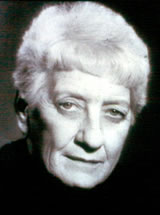
|
Tharon Musser
Lighting Through The Glass Ceiling
Reflections on Tharon Musser
Tharon Musser (1924-2009) was an American lighting designer. She earned an MA at Yale School of Drama in 1950, and then worked in New York till the end of the 20th century.
She lit countless Broadway plays and musicals, and revolutionized the field of lighting design by being the first to use a computerized lighting console on Broadway,
in her work on A Chorus Line (1975).
Excerpt:
|
She often said that sometimes designers specified too much equipment and just made "mush" on stage, or what she called "supermarket lighting."
"You don't see a point of view on stage, just mush." She believed in solving the technical problems at her drafting board - not by adding a lot
of equipment to cover mistakes.
|
Designs and papers
Video interview, along with light plot and paperwork for A Chorus Line
For ‘Chorus Line,’ a ‘Moon Shot’ of Broadway Lighting: 1975 New York Times article on Tharon Musser's groundbreaking lighting design.
|
|

|
Jean Rosenthal
Jean Rosenthal's Light: Making Visible the Magician
by Mary Callahan Boone
Jean Rosenthal was one of the early pioneers both
of lighting design as an art form and of women as full participants in the
world of technical theater.
Excerpt:
|
As Jean Rosenthal described the narrow, formulaic conventions
of lighting that dominated the theatrical stage as late as
the 1930s, "Comedies were bright; dramas were uncheerful.
Day was yellow; night blue. Effects were naive".
Rosenthal's use of light revolutionized the art of theatrical
lighting, and her work (along with that of Abe Feder and
Peggy Clark Kelly) established the specialized area of
lighting design. In addition to specific lighting innovations,
Rosenthal's ability to create an atmosphere unique to each
show put her in demand as a Broadway lighting designer.
|
|
|

|
Tom Skelton
Handbook of Dance Stagecraft
by Tom Skelton
From October, 1955 through December, 1956, Dance Magazine
published a series of articles by Tom Skelton.
Excerpt:
|
Most dancers today seem to be very much concerned with their lighting,
which is as it should be since good lighting can be a very expressive tool.
While it may not be true that good lighting can “make” a dance great,
it is certainly true that good lighting can make a good dance better,
and that bad lighting can ruin even a fine dance.
|
|
|

|
Loie Fuller, Jean Rosenthal, and Jennifer Tipton
The light fantastic - Fuller, Rosenthal & Tipton:
beginning with Loie Fuller in the nineteenth century, dance has pioneered the development of twentieth-century stage lighting.
by Martha Ullman West
Three pioneers in dance lighting.
Excerpt:
|
The marriage of light and dance was certainly the meeting of
two like minds. Both move through time and air and space;
both are ephemeral - always changing, never still,
The courtship may have begun when the American dancer Loie
Fuller projected red, blue, and yellow painted lights onto
her white silk costume a century ago. Only technological
limitations prevented a more perfect union, and today computer
technology that makes ever more sophisticated lighting
equipment possible can unite artistic imagination with the
means of expressing it as never before.
|
|
|

|
in 1: the podcast
in 1: the podcast
by Cory Pattak
Free-ranging discussions with designers, lighting and otherwise.
Excerpt:
|
You know those conversations you have at the bar after a long day of tech?
The moments where you sit with your friends and colleagues and discuss what you
love about being a designer, but also what drives you mad? Imagine getting to
listen in on those conversations with some of the most fascinating, celebrated,
and sought after theatrical designers working today. That is what in 1: the
podcast strives to be. A long-form, uncensored, candid chat with designers
of all walks of life talking about their lives in the theatre. No topic is off
limits. From life on the road to life in a Broadway theatre. From trying to get
noticed in New York to making a splash in regional theatre. You’ll never know what
to expect from each episode. You might learn about a designer’s latest inspiration,
or how they got started, their most embarrassing moment, or their favorite
collaborator
|
|
|